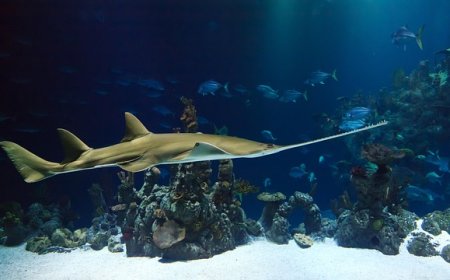All About Stingrays for Students: Graceful Gliders with a Hidden Stinger
All About Stingrays for Students: Graceful Gliders with a Hidden Stinger

🦈 Stingrays: Graceful Gliders with a Hidden Stinger
Stingrays are flat, graceful sea creatures that glide across the ocean floor like flying carpets. They belong to the ray family, closely related to sharks and manta rays. While they look peaceful—and often are—they have a special defense: a venomous stinger on their tail.
There are over 200 species of stingrays in many shapes and sizes. Some live in the ocean, others in rivers and freshwater lakes. Most stingrays are harmless to humans and only use their sting when threatened.
🌍 Habitat and Geographic Range
Stingrays live in a variety of environments, including:
- Shallow coastal waters and coral reefs
- Estuaries and mangroves
- Open ocean
- Freshwater rivers and lakes, like the Amazon River stingray
They’re found worldwide in warm, tropical regions, including Florida & the Gulf of Mexico, Australia’s Great Barrier Reef, Southeast Asia, the Indian Ocean, and South America’s freshwater systems.
As bottom dwellers, they like sandy seafloors where they can hide by burying themselves with only their eyes and spiracles (breathing holes) exposed.
🦐 Diet and Feeding Behavior
Stingrays are carnivores eating:
- Crabs and shrimp
- Clams and oysters
- Worms and small fish
- Squid (larger species)
They use electroreception to sense prey under the sand, then employ:
- Strong jaws & flat teeth to crush shells
- Suction-like mouth to draw in soft prey
Some species hunt by day, others feed mostly at night.
🧥 Physical Features and Adaptations
Key features include:
- Flattened bodies shaped like discs or diamonds
- Broad pectoral fins that glide like wings
- Spiracles behind the eyes for breathing while buried
- Eyes on top, with mouth and gills on the underside
- Cartilage skeletons for lightness and flexibility
- Long, whip-like tails often bearing venomous barbs
The tail barb is for defense, not hunting; most stings occur when someone accidentally steps on a ray hidden in the sand.
👥 Behavior and Stingray Safety
Stingrays are usually shy and gentle, swimming alone or in small groups called fevers. They communicate via body language:
- Burying themselves to hide
- Flapping fins to stir up prey
- Breaching (rare jumps out of water)
🛡️ Staying safe around stingrays:
- Do the “stingray shuffle”—shuffle feet in shallow water to avoid stepping on one
- Never touch or pick up a wild stingray
- Observe from a safe distance when snorkeling or diving
Most stings are non–fatal but painful. In controlled settings, barbs are sometimes trimmed to prevent injury.
🍼 Life Cycle and Reproduction
Stingrays are ovoviviparous:
- They carry eggs inside their bodies
- Eggs hatch internally
- The mother gives birth to live young
Depending on species, they bear 2–10 pups fully formed and ready to swim & feed on their own.
Most mature by 3–5 years and live 15–25 years.
⚠️ Threats and Conservation
Main threats include:
- Overfishing for meat & skin
- Bycatch in commercial nets
- Habitat loss from development & pollution
- Climate change affecting food & temperature
Some species, especially giant freshwater rays, are now endangered.
🛡️ Conservation efforts:
- Marine protected areas
- Sustainable fishing regulations
- Public education on rays’ ecosystem role
- Global monitoring & research
🎉 Fun Facts About Stingrays
- A group of stingrays is called a fever
- Some grow over 16 feet wide (giant freshwater ray)
- They’ve existed for 150 million years
- Skin covered in tiny tooth-like scales
- They “fly” underwater by flapping their fins
🧠 Vocabulary List
- Cartilage – Flexible tissue forming their skeleton
- Spiracles – Openings behind the eyes for drawing in water
- Bottom dweller – Lives on the sea floor
- Barb – Venomous spine on the tail
- Ovoviviparous – Live birth from eggs hatched inside mother
- Fever – A group of stingrays
- Bycatch – Animals caught accidentally in fishing gear
- Electroreception – Sensing electrical fields of prey
- Camouflage – Blending into surroundings
- Venom – Poison used for defense
✅ Stingray Quiz: Sting or Swim?
1. What is the stingray’s tail used for?
A. To catch food
B. For defense with a venomous barb
C. To help it eat
D. For dancing
2. What do stingrays mostly eat?
A. Seaweed
B. Plankton
C. Crabs, clams, and small fish
D. Birds
3. Where are a stingray’s eyes?
A. Under its body
B. On top of its body
C. On its tail
D. Inside its mouth
4. How do stingrays breathe while lying flat?
A. Through their nose
B. Through their tail
C. With spiracles behind their eyes
D. Through their fins
5. What is a group of stingrays called?
A. Pack
B. Fever
C. Pod
D. Swarm
🧒 Kid-Friendly Summary
Stingrays are flat, flying carpet–like fish that live on the ocean floor. They eat crabs, shrimp, and clams, gliding with their wing-like fins. They have tails with venomous barbs, but only sting to protect themselves.
To stay safe, do the “stingray shuffle” when wading. Stingrays are fascinating creatures that help keep our oceans healthy—and they need our protection too!





















































